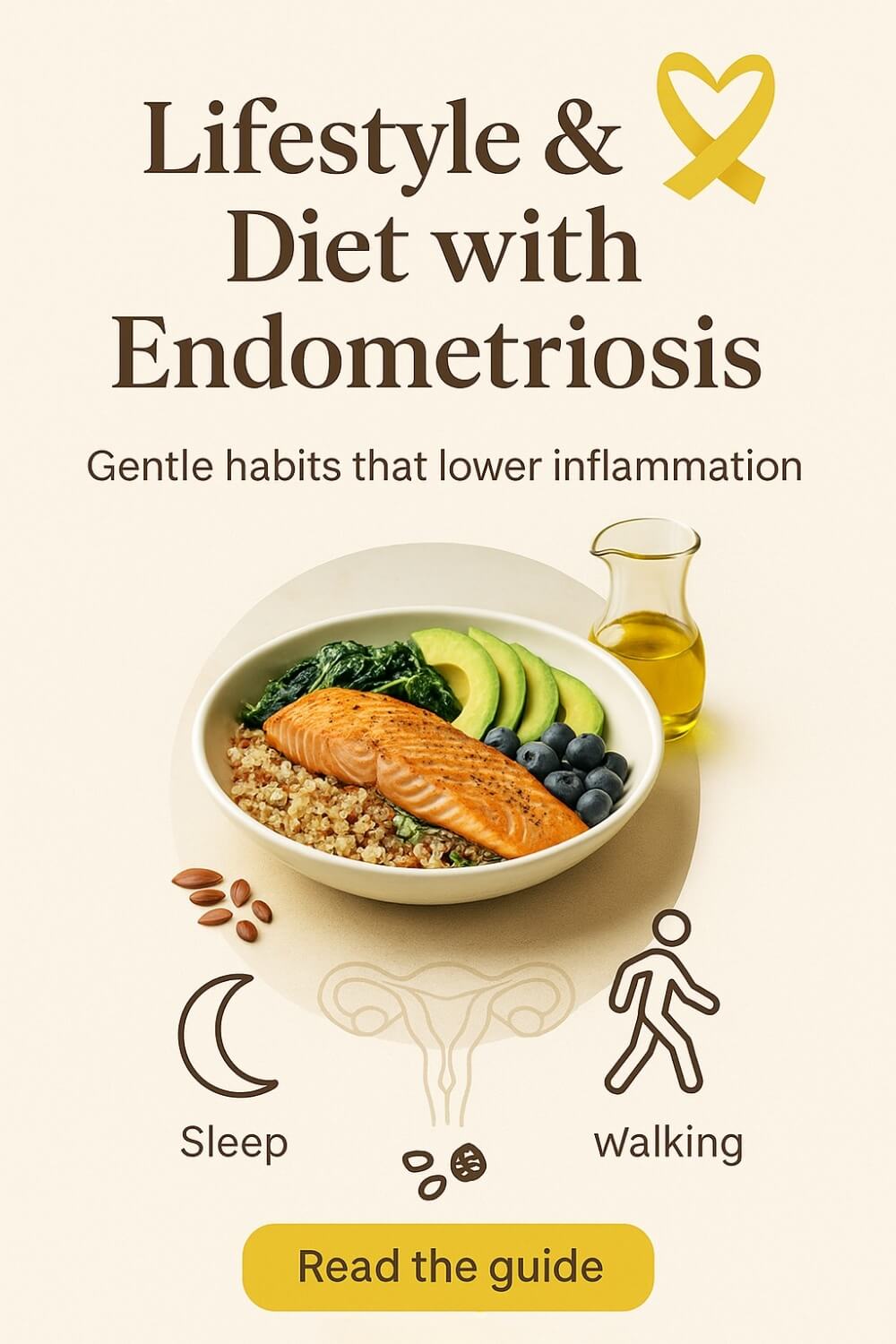Lifestyle & Diet with Endometriosis
Can lifestyle & diet with endometriosis truly change how you feel?
Yes. While there is no curative diet, lifestyle & diet with endometriosis can ease pain by lowering inflammation, supporting gut health, and managing estrogen load. Evidence favors whole foods, fiber, omega-3s, and exercise while limiting alcohol, ultra-processed fats, and some triggers daily.
New reviews in 2024–2025 point to Mediterranean-style patterns, higher vegetables, fiber, and omega-3s as helpful, while ultra-processed fats and excess alcohol correlate with worse symptoms. Large survey data also suggest that many people feel better reducing alcohol, caffeine, gluten, and some dairy.
Guidelines still call the evidence modest, but endorse a healthy diet and regular activity alongside medical care.
I’ve watched my wife fight this disease with courage. When we tuned food, movement, and rest around her flares, the bad days didn’t vanish, but they softened, and we got parts of our life back.
If this resonates, you can grab a free chapter of my book “Endo-Tool: Endometriosis for Men.” By joining, you’ll also become part of our community where I send more freebies, big discounts on all our books, and practical, heart-level tools to help couples adjust to the new normal.
The first chapter alone contains all the comprehensive medical knowledge about endometriosis, including:
- What is endometriosis?
- What are the symptoms?
- What causes endometriosis?
- What does endometriosis look like?
- What are the stages?
- What are the types?
- What is adenomyosis, and how is it related to endometriosis?
- Why do some women develop severe endo and others don’t?
- Does endometriosis cause infertility?
- How is endometriosis diagnosed?
- Do types and stages affect the treatment?
- Recurrence of endometriosis after excision surgery.
FREE Chapter of “Endo-Tool”
Endometriosis e-Book for Men
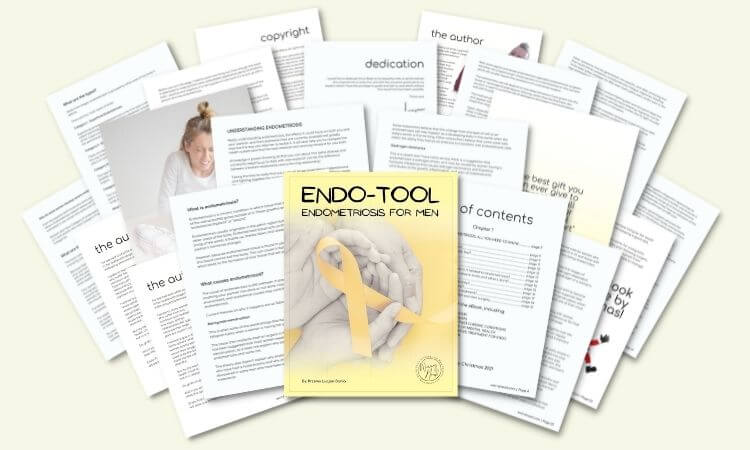
- How Lifestyle & Diet with Endometriosis Can Reshape Your Days?
- Deep Practice of Lifestyle & Diet with Endometriosis
- Healing Rhythms with Lifestyle & Diet with Endometriosis
- Steadier Seasons of Lifestyle & Diet with Endometriosis
- Final Word on Lifestyle & Diet with Endometriosis
- Lifestyle & Diet with Endometriosis FAQs
- Lifestyle & Diet with Endometriosis References
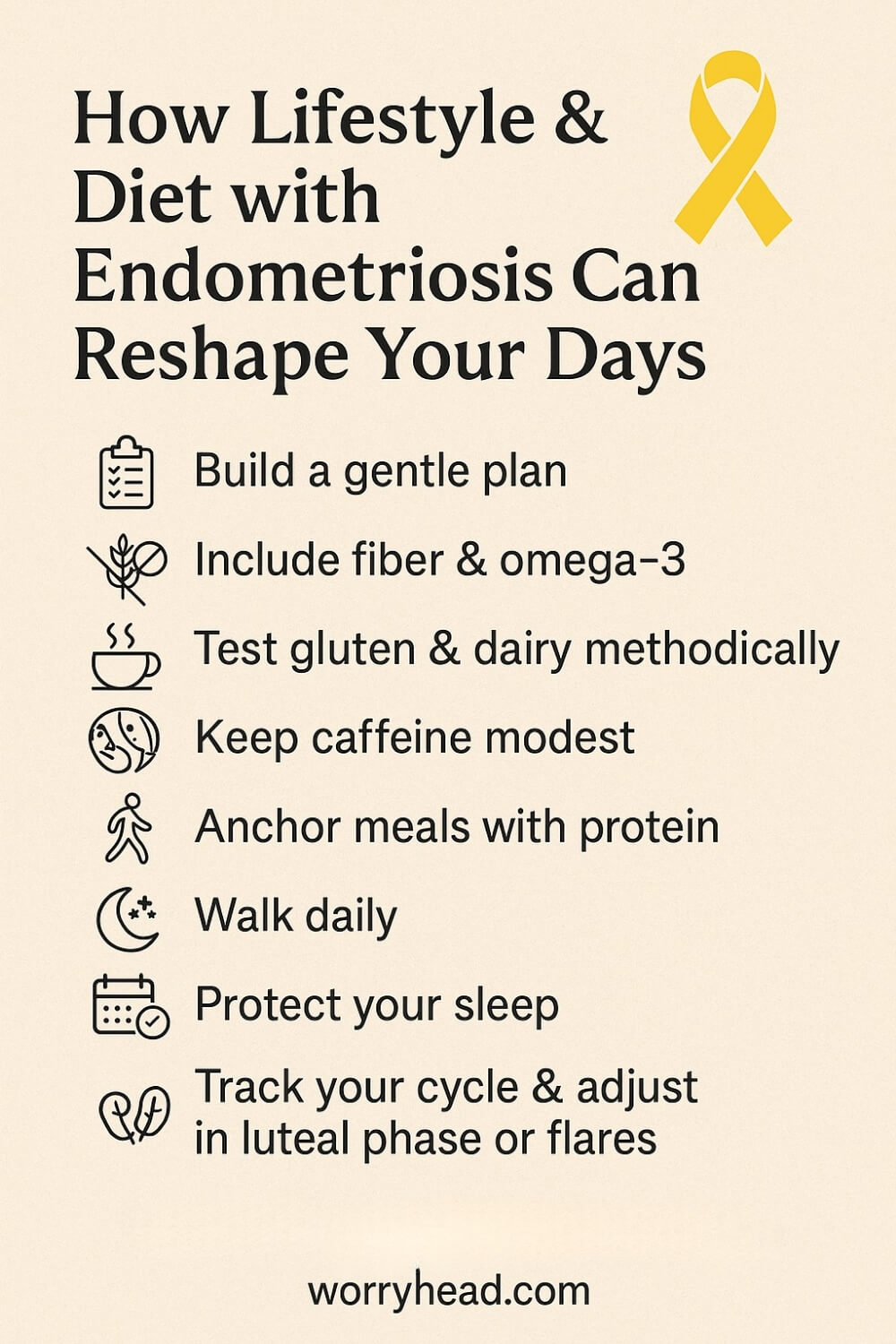
How Lifestyle & Diet with Endometriosis Can Reshape Your Days?
There’s a quiet power in small, repeatable choices. Food becomes more than fuel when pain keeps stealing hours, and routines start to anchor a life that often feels unsteady. I’ve learned that progress is rarely dramatic. It’s the gentle consistency of what you plate, how you move, and when you rest.
Patterns matter. A steady meal rhythm calms blood sugar swings that can amplify cramps and fatigue. Hydration seems simple, yet it cushions headaches and keeps digestion moving when bloat and constipation make everything feel tender.
I lean toward a Mediterranean-style plate because it’s practical. Colorful vegetables, olive oil, legumes, and oily fish give you anti-inflammatory building blocks without turning meals into a project. It’s not a cure, but it stacks the odds in your favor.
Protein at each meal steadies energy, while fiber from berries, greens, and pulses helps with estrogen metabolism. Many women notice less flare intensity when ultra-processed snacks are swapped for nuts, seeds, and real food you can recognize.
Some find that reducing gluten or certain dairy eases symptoms. Others discover that it doesn’t. The win is testing one change at a time for two to four weeks, so you know what actually helps you rather than chasing every internet rule.
Caffeine can be tricky. A single morning coffee may be fine, but frequent cups can spike anxiety and sleep disruption, and poor sleep makes pain meaner. If you experiment, taper rather than quit outright to avoid rebound headaches.
Movement is medicine when it’s kind. Walking, yoga, light strength, and breath-led mobility build stamina without provoking a flare. On heavy days, five minutes is still a victory. The body remembers that you showed up.
Sleep is the most overlooked therapy. A consistent wind-down, a cooler bedroom, and a screens-off buffer create space for deeper rest. Better sleep blunts inflammation, and the next day feels more survivable.
Supplements can help, but basics first. Omega-3s, magnesium, and vitamin D are common foundations, yet they’re additions, not replacements for meals, movement, and sleep. Keep notes, and change one variable at a time.
Stress lives in the body. Gentle nervous-system work, slow exhales, box breathing, and short mindfulness check-ins can lower the volume of pain. You don’t need an hour. You need a small practice you’ll keep.
None of this is all-or-nothing. The goal is not perfect adherence. It’s identifying the few levers that give you the biggest relief and pulling them most days. That is how momentum is built.
We learned this the slow way. My wife and I tracked flares, meals, caffeine, and sleep, and patterns emerged. When we honored them, bad days softened. Not erased, but softened enough that hope felt honest again.
Before we get practical, I want you to have the most useful, real-life tips we lean on at home. These are the things we return to when pain tries to run the day:
- Build a gentle endo diet meal plan you’ll actually follow
- Prioritize fiber, omega-3s, and colorful plants
- Test gluten and dairy reductions methodically
- Keep caffeine modest and morning-only
- Anchor protein at every meal and snack
- Walk daily and add two light strength sessions
- Guard sleep with a consistent wind-down routine
- Track symptoms against food, stress, and cycle
- Adjust gently during the luteal phase and flares
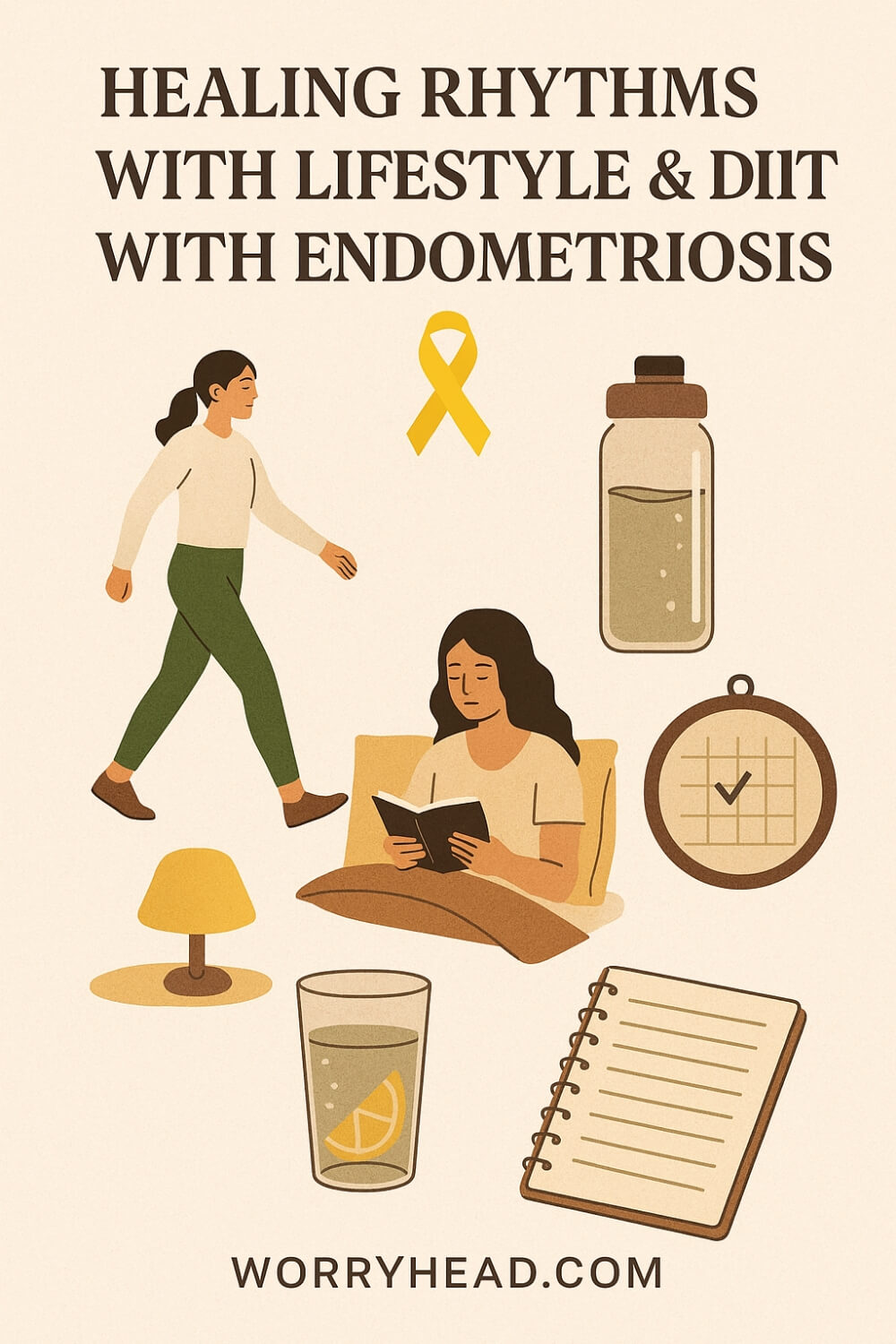
Create a Gentle Endo-Meal Plan
Start where you are, not where a perfect plan lives on paper. A gentle endo meal plan is one you’ll actually follow on rough days and on ordinary Tuesdays. We map three simple meals and two flexible snacks, then repeat the hits so decision fatigue doesn’t steal your energy.
I build her plate around familiar flavors, then nudge it toward color, fiber, and healthy fats. Batch-cooking grains, roasting trays of veg, and freezing salmon portions turn “what now?” into “heat and eat.” On flare days, soft foods, soups, stews, and slow-cooked proteins are kinder on the gut.
We keep room for comfort. One sweet thing after dinner, portioned and planned, respects cravings without letting them drive. Progress isn’t rigid; it’s a compassionate structure you can lean on when pain tries to blow the day apart.
Prioritize Fiber and Omega-3s Daily
Fiber moves estrogen metabolites along so they don’t linger, and it steadies blood sugar that loves to swing during pain. We aim for berries, leafy greens, beans, and seeds most days, building salads with heft and soups with lentils that actually satisfy. A bowl that fills you is more protective than rules you can’t keep.
Omega-3s are our quiet bodyguards. Two fish meals a week or a quality supplement give her joints and pelvis something anti-inflammatory to work with. We sprinkle ground flax and chia on breakfast, whisk olive oil into dressings, and let nuts replace ultra-processed snacks.
The shift is subtle but accumulative. Digestion eases, bloating softens, and energy evens out enough that hope has room to breathe again.
Test Gluten and Dairy Methodically
We don’t chase every internet promise. Instead, we run clean experiments. Two to four weeks gluten-light, then a calm reintroduction while tracking pain, bloat, and fatigue. Later, we repeat the process with dairy, starting with fermented options like yogurt and kefir before deciding what belongs.
It’s not about restriction as identity; it’s about clarity. If symptoms ease, we keep the dial turned down without making food the enemy. If nothing changes, we let it go and reclaim those foods without guilt.
This approach protects her body and her mind. Food becomes information, not a battleground. And we gain confidence that our choices are helping because we watched them help, not because someone shouted a rule.
Keep Caffeine Modest, Morning-Only
Pain steals sleep, and poor sleep magnifies pain. Caffeine can bridge the gap, but it can also fray nerves and hijack rest. We cap intake at one small cup in the morning, sipped with protein and fiber, so it lands softer. Then we switch to water or herbal tea and let the nervous system exhale.
If a taper is needed, we step down over a week, half-caf, then decaf, so headaches don’t join the party. On high-fatigue days, we borrow energy from light movement and daylight instead of another cup.
Even this single change made her evenings quieter. Falling asleep got easier, and waking felt less like climbing a hill with a backpack full of stones.
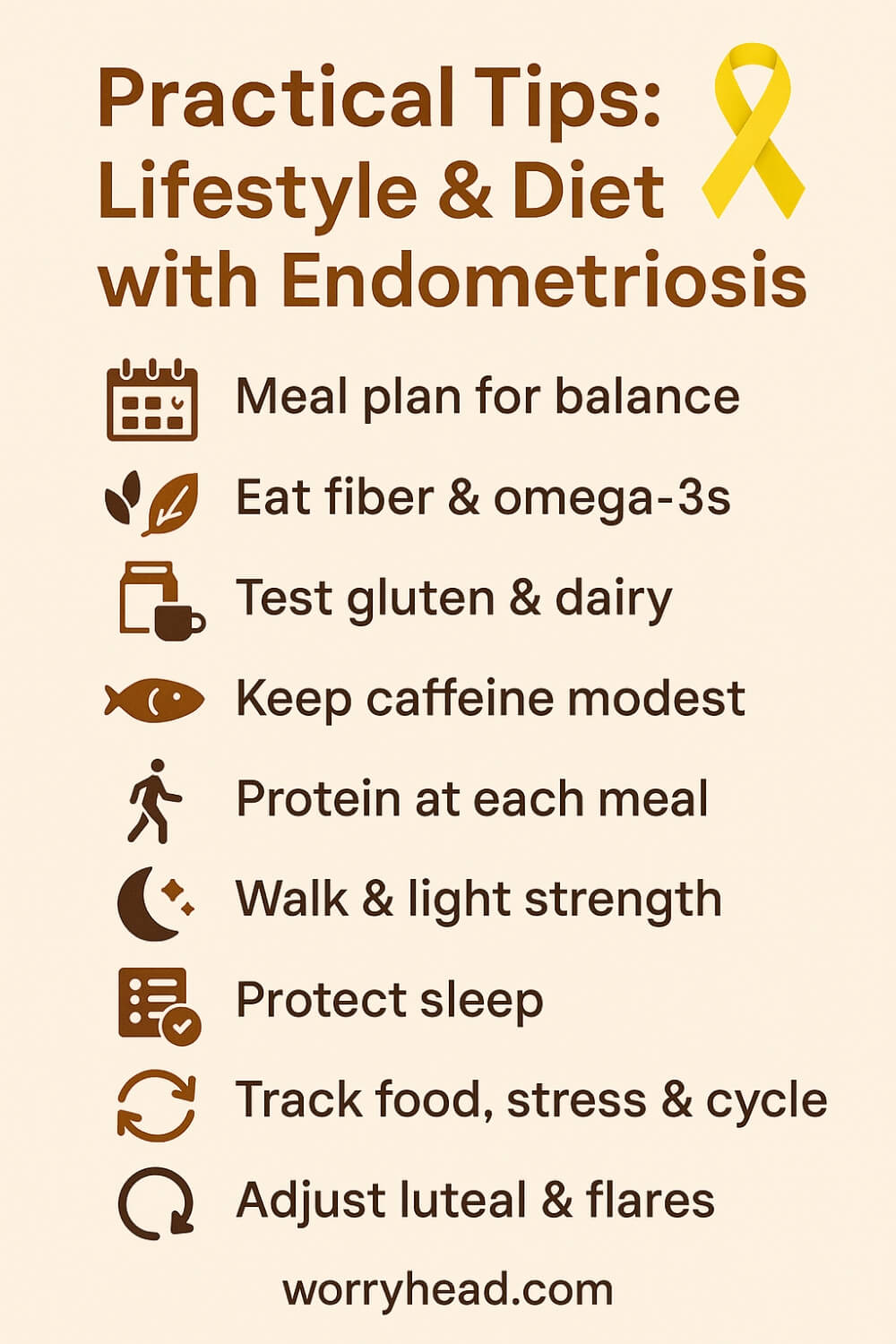
Anchor Protein at Every Meal
Protein is in balance in a chaotic week. It slows digestion, tempers cravings, and supports recovery when inflammation is loud. We anchor each meal with eggs, fish, tofu, chicken, or legumes, and keep easy options ready: tuna tins, edamame, hummus, Greek-style yogurt, so there’s always a “yes” within reach.
Pairing protein with fiber and healthy fats makes a plate that satisfies without heaviness. A chickpea salad with olive oil, lemon, and herbs; baked salmon over quinoa and greens; a tofu stir-fry with ginger and veg, fast, friendly, repeatable.
When her protein is consistent, crashes happen less, and the long afternoons feel doable rather than daunting.
Walk Daily, Add Light Strength
Movement is a negotiation, not a punishment. We start with a ten-minute walk most days, adding minutes when her body says yes. On better weeks, two short strength sessions, bodyweight, bands, or light dumbbells, build resilience without poking the bear. First, breathe steadily, stop before pain flares.
On tender days, we trade intensity for consistency: gentle mobility, pelvic floor-friendly sequences, and breath-led stretches that make space rather than demand it. Sunlight on skin, even for five minutes, is medicine we can take for free.
Over time, stamina returns in small, proud increments. Not overnight, but undeniably. She owns a little more of each day.
Protect Sleep with Wind-Down Routine
Sleep is a therapy we can practice nightly. We guard the last hour: dim lights, warm shower, screens parked outside the bedroom. A light snack with protein and complex carbs cushions blood sugar dips that wake her at 3 a.m. The room stays cool and quiet, a place her nervous system learns to trust.
We stack calm, stretching, a few pages of a gentle book, three slow breaths out longer than in. If pain chatters, heat pads and a supportive pillow setup ease the edge. We keep wake times steady so her body clock has something reliable to hold.
Better sleep doesn’t fix everything, but it lifts everything. Mornings feel less cruel, and choices feel possible again.
Track Food, Stress, and Cycle
We keep a simple log, not a surveillance camera. What she ate, how she slept, stress notes, movement, and where she is in her cycle. Patterns emerge, certain foods are tolerated better in follicular days, more rest is needed in late luteal, and specific stressors that cash out as cramps.
With data, we forecast instead of react. We prep softer meals before period week, dial back caffeine when anxiety hums, and book the hardest tasks for days that historically feel kinder. The log lives to empower, not judge.
Over months, this turns bewilderment into agency. We stop guessing and start steering, gently but unmistakably, toward days with less pain.
Adjust During the Luteal Phase, Flares
The late luteal window can magnify everything. We plan for it like the weather. Meals tilt warmer and simpler, salt and magnesium get attention, and workouts shift to walking, mobility, and breath. Social load lightens where possible; boundaries thicken to protect sleep and recovery.
During flares, we shrink the target. One nourishing bowl, one short walk, one kind choice at a time. We keep a flare kit ready, heat pad, easy proteins, ginger tea, and a favorite show, so comfort is closer than panic.
This isn’t surrender. It’s a strategy. Meeting her body where it is shortens the storm and helps the next day arrive with less debris.
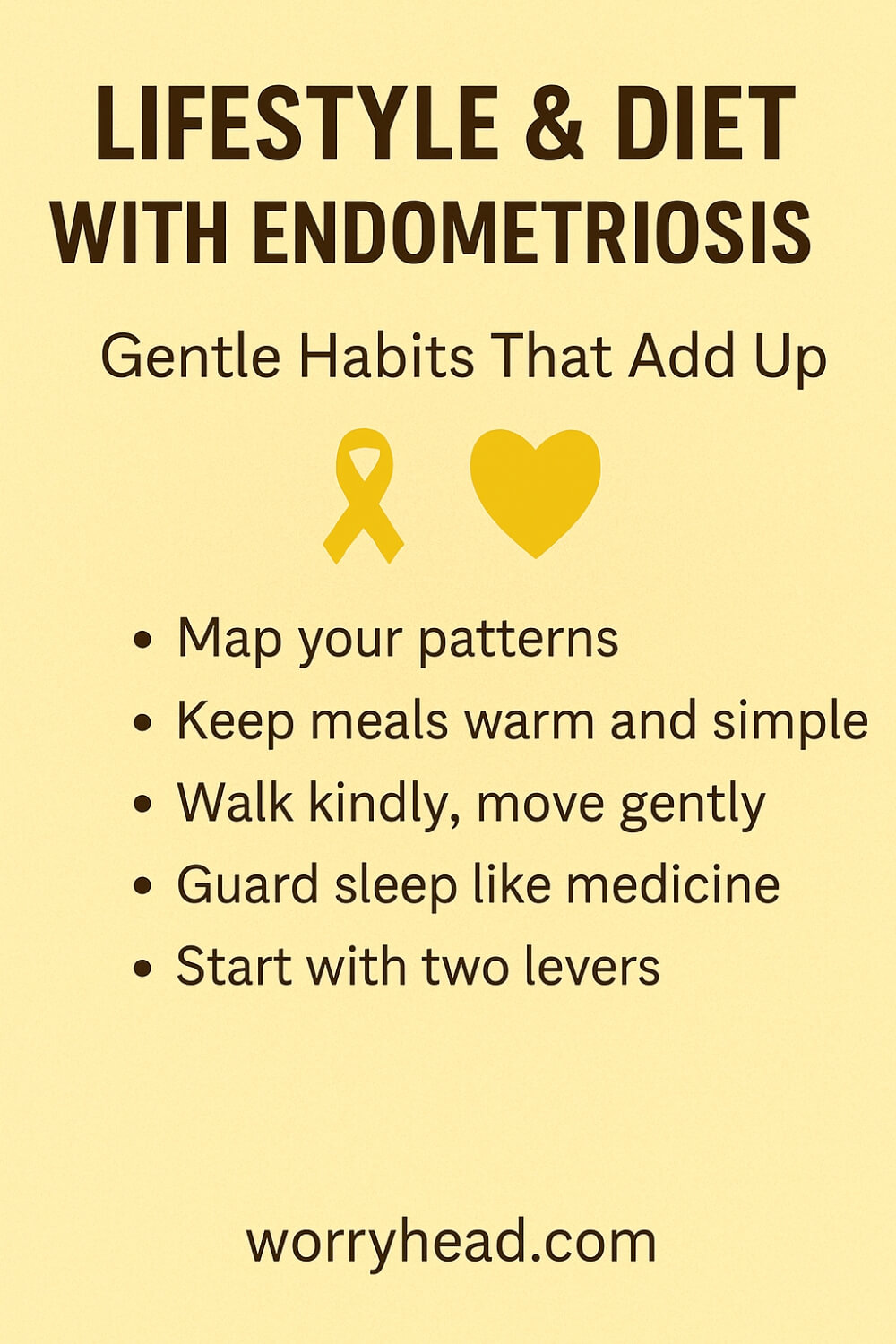
Deep Practice of Lifestyle & Diet with Endometriosis
Change begins where your fork and your breath meet the hardest hours. We learned to treat meals, movement, and rest as levers, not lectures. Small levers pulled often move heavier days than perfect plans pulled rarely.
Inflammation hates predictability, so we gave it some. Regular mealtimes steadied energy, and warm, simple bowls replaced last-minute fixes that left her wired and empty. On better days, we cooked a little extra so the tired days had something kind waiting.
Gut ease became a north star. We kept fiber high but textures gentle, added fermented foods she actually liked, and watched how stress tightened everything. A slower table, longer chews, and five quiet breaths before eating changed more than any supplement.
We protected hormones with ordinary food. Color on the plate, olive oil in the pan, fish in the week, and brassicas often enough to matter. Nothing exotic, just repetition, because the body believes what you repeat.
Movement turned from punishment into promise. Walks opened space, light strength rebuilt trust, and mobility work made room where pain had been squatting. On flare days, we shrank the target to five minutes and called it a win.
Sleep became our scaffolding. The last hour of the day softened on purpose, and the room told her nervous system a single message: you are safe. When nights improved, mornings stopped feeling like a wall.
I watched her shoulders drop when a week went right. There were still spikes, still sudden griefs, but they didn’t own the whole day. We had tools on the counter and mercy in the schedule.
If you’re reading this in the thick of it, know this is how we got pieces of our lives back. Not with grand gestures, but with a thousand small loyalties to the body that is doing its best.
Healing Rhythms with Lifestyle & Diet with Endometriosis
I used to think relief would arrive as a single big fix, but what helped most were tiny, loyal habits that learned her body’s language. We kept the meals simple and predictable, and her nervous system started to unclench.
When breakfast held protein, fiber, and something warm, the morning cramps were less sharp. A bowl of oats with flax, berries, and a spoon of yogurt steadied her better than any rule ever did.
Midday, we aimed for color and calm digestion. Soups, soft grains, and gentle spices sat kinder than heavy lunches that left her bloated and foggy.
Evenings were about restoration, not perfection. Olive oil over roasted vegetables, salmon or beans for protein, and a small comfort on the side made the day feel human instead of clinical.
Hydration became a quiet ally. When she was well hydrated, headaches eased and her gut moved without that slow, aching protest.
We learned to plan for the hard days. Before the luteal phase, we cooked extra, made the freezer a safety net, and cleared space on the calendar so rest could happen without guilt.
Movement was measured by kindness, not intensity. Ten minutes of walking counted. A few breaths that lengthened on the exhale counted. Small wins piled up into a body that trusted itself again.
Caffeine was trimmed to the morning, and sleep became sacred. A warm shower, a book, a dark room, and the phone outside the door changed her nights more than any supplement.
I kept notes so she did not have to remember patterns through pain. When a flare loomed, I knew what to cook, when to suggest a walk, and when to simply sit with her.
There were nights I watched her curl around the hurt and felt useless. What saved me from that helpless place was action in miniatures, the next kind choice, the next steady meal, the next quiet hour.
It is not a dramatic story. It is a careful one. And careful, repeated choices softened the edges that used to cut straight through our days.
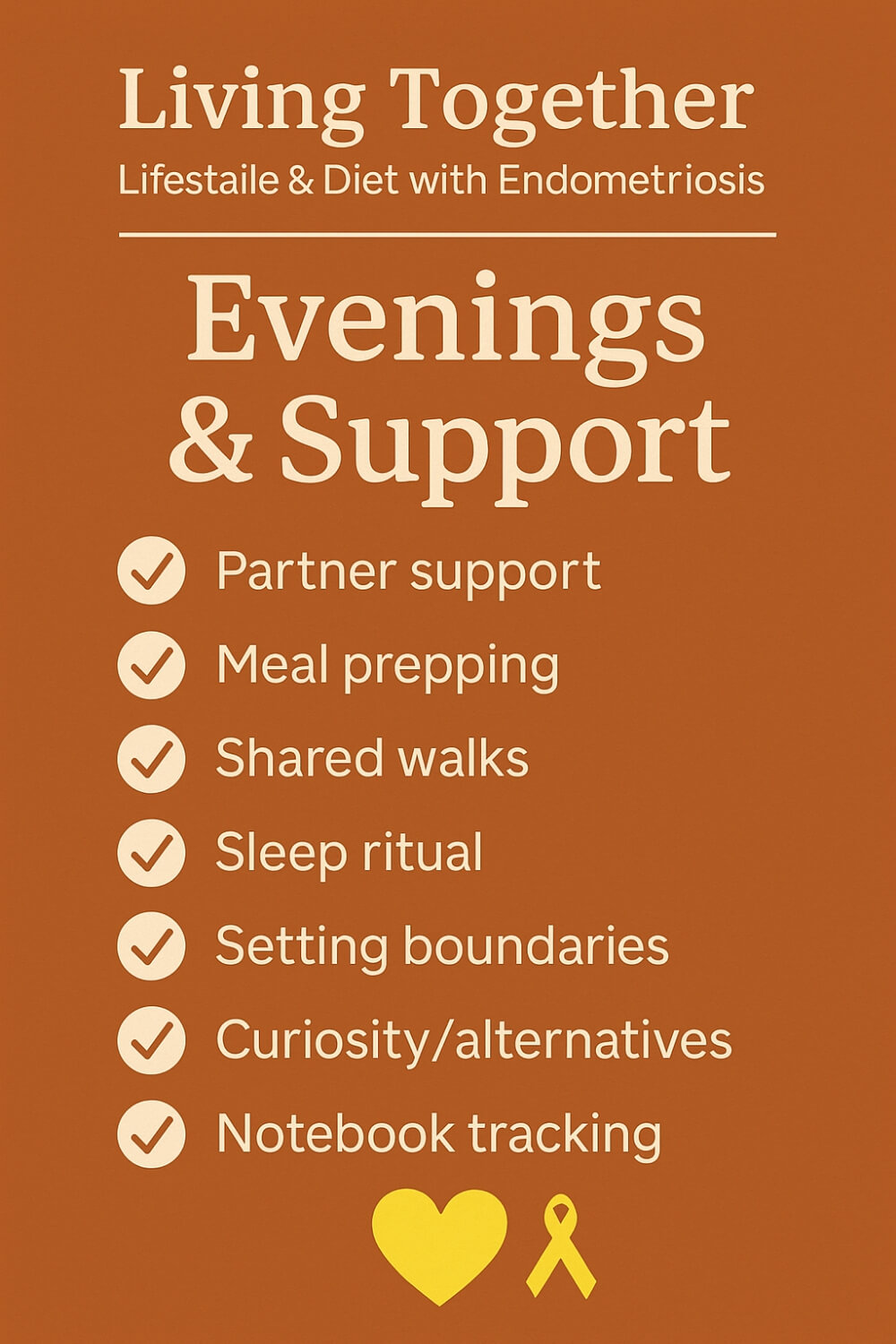
Steadier Seasons of Lifestyle & Diet with Endometriosis
When we stopped chasing perfection and started honoring patterns, the house got quieter. Meals became signals of safety, not tests she could fail. That safety spilled into our evenings, and even hard nights felt less lonely.
I learned that my job wasn’t to fix her, but to remove friction. I prepped gentle proteins, kept the pantry stocked with soft grains, and made sure there was always something she could say yes to. The smallest yes changes the direction of a day.
We set boundaries around energy leaks, late scrolls, overstretched commitments, and the “shoulds” that leave you hollow. Protecting her bandwidth protected mine, and we both had more to give where it mattered.
On flare weeks, I carry the practical weight so she carries less of the invisible one. I handle the shops, the washing, the admin, and I keep the calendar. Care is quieter than heroics, but it lasts longer.
Movement became a shared language. If she walked, I walked. If she stretched, I stretched beside her. That simple togetherness turned discipline into something warm instead of punishing.
Sleep is our nightly truce with pain. We guard the ritual, keep lights low, and let conversation soften instead of spiraling. Rest doesn’t cure, but it returns pieces of her that pain tries to steal.
We keep curiosity alive. If a food bothers her, we don’t mourn it, we explore alternatives until dinner tastes like comfort again. It’s not a restriction; it’s craftsmanship.
I keep a notebook of what helped and when, so future us doesn’t have to relearn it in the fog. Patterns remembered are pain avoided. Patterns honored are hope made practical.
There’s only one rule I hold hard: we treat each other gently, especially when the body isn’t gentle. That rule shapes meals, plans, and the tone of our home.
And somewhere inside those ordinary choices, we found more ordinary days, the kind that feel like living, not just coping. That’s the quiet promise of this work.
Final Word on Lifestyle & Diet with Endometriosis
If there’s one lesson our home keeps teaching me, it’s that healing isn’t a finish line, it’s a rhythm. The days that go better don’t arrive by accident. They’re built quietly from ordinary choices repeated with care: a gentler breakfast, a kinder walk, a stricter bedtime, a softer plan for the week that tends to real bodies and real limits. None of this is flashy. All of it is powerful.
I used to aim for perfect, then blame myself when perfect slipped through my fingers. Now I aim for steady. Steady is packing the freezer before the tough days. Steady is switching to the second coffee for daylight and a few deep breaths. Steady is stocking the cupboard so there’s always a “yes” within reach, even when pain is loud. Steady is choosing foods that comfort without costing tomorrow.
We learned to see patterns, not just problems. Pain has seasons; so do energy, mood, digestion, and sleep. When we map those tides, we stop fighting the sea and start sailing it. Meals are tilted warmer when cramps threaten. Strength work gives way to walking when the body whispers, “not today.” We trade self-judgment for self-respect and call that progress.
Support, I’ve learned, is logistics with love inside. It’s doing the shop, prepping the soup, guarding the calendar, and refusing to let shame into the kitchen. It’s saying, “You are not a burden,” with every practical thing you quietly remove from her path. It’s being the one who remembers what helped last month, so she doesn’t have to.
And still, some days will be hard. On those days, we shrink the target. One nourishing bowl. One short walk. One warm shower. One early night. We let “enough” be enough. We try again when morning comes, because mornings do come, and hope is a habit too.
If you’re reading this exhausted, please hear me: you are not failing; you are adapting. Start where you stand. Choose two levers, sleep and protein, or walks and hydration, and pull them most days. Keep a simple log. Forgive the detours. Celebrate the quiet wins that no one on the internet can see. That is how life gets bigger around the pain.
I’m just a husband who loves a woman who hurts and refuses to let that be the end of the story. These small, loyal actions gave us back pieces of our lives. I believe they can give you back pieces of yours, too.
When pain feels louder than your plans, trade perfect for steady. Map your patterns, keep meals warm and simple, walk kindly, and guard sleep like medicine. Start with two levers, track gently, and let quiet wins stack. Relief grows from ordinary choices repeated with care.
Have a question or a tip that helped you? Leave a comment, I read every one. And if this resonated, grab a free chapter of my “Endo-Tool: Endometriosis for Men.” You’ll join our community for more freebies, big discounts on all our books, and real-life tools that help couples adapt with love.
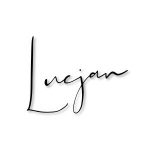

About Me
Hi, I’m Lucjan! The reason why I decided to create this blog was my beautiful wife, who experienced a lot of pain in life, but also the lack of information about endometriosis and fibromyalgia for men…
READ MORELifestyle & Diet with Endometriosis FAQs
1) Is there one “best” diet for endometriosis?
There isn’t a single curative plan. Most people do best with a Mediterranean-style pattern: plenty of vegetables and fruit, legumes, whole grains that you tolerate, olive oil, nuts/seeds, and regular omega-3s (oily fish or flax/chia). Limit ultra-processed foods, excess sugar, and alcohol. Treat it as a sustainable lifestyle, not a short-term fix.
2) Should I cut out gluten or dairy?
Maybe—but test methodically. Try a 2–4 week gluten-light trial while tracking pain, bloat, and energy, then reintroduce and observe. Repeat later with dairy, starting with fermented options like yogurt/kefir. Keep what helps, drop what doesn’t; the goal is clarity, not restriction for its own sake.
3) Does caffeine make endometriosis worse?
Caffeine can amplify anxiety and disrupt sleep, and poor sleep can heighten pain. Many feel better keeping it modest and morning-only (e.g., one small cup with food). If you’re drinking multiple cups, taper gradually to avoid rebound headaches and use light movement and daylight for energy instead of an afternoon coffee.
4) Which supplements are worth considering?
Food, sleep, and movement are the foundations. Common add-ons include omega-3 (EPA/DHA), magnesium (often glycinate at night), and vitamin D if you’re low. Some explore ginger or curcumin for inflammation. Start one at a time, note effects for 2–4 weeks, and speak with your clinician—especially if you’re on hormonal therapy or anticoagulants.
5) Can lifestyle and diet support fertility with endometriosis?
Healthy patterns can support overall reproductive health—steady protein, fiber for estrogen metabolism, omega-3s, and a diverse, colorful plate. Keeping alcohol low, not smoking, prioritizing sleep, and managing stress all help the terrain. They don’t replace medical care, but they can complement it while you work with your gynecologist or fertility team.
Lifestyle & Diet with Endometriosis References
- Endometriosis UK — The role of diet and nutrition in the management of endometriosis
- NICE Guideline NG73 — Endometriosis: diagnosis and management (PDF)
- NICE research recommendation — Lifestyle interventions (diet and exercise) in endometriosis
- Cleveland Clinic — Endometriosis Diet: Foods To Eat and Avoid
- PMC — Impact of lifestyle and diet on endometriosis: a fresh look at inflammation-related linkages (2022 review)
- PMC — Nutrition in the prevention and treatment of endometriosis (2023 review)
- MDPI — The Importance of Diet in the Treatment of Endometriosis (2024 review)
- Frontiers in Nutrition — Effect of dietary patterns and nutritional supplementation in endometriosis (2025)
- Worcestershire Acute Hospitals NHS — Diet and Endometriosis (patient leaflet, 2025)
- The Endometriosis Foundation — Diet & Lifestyle overview
